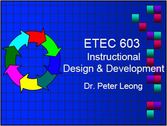The First Year Artifact - Instructional Design for ETEC 603
ETEC 603 Instructional Design - How much sodium in your portion?

This final instructional design project was a team effort intended to demonstrate skills in
planning and executing instructional analysis, design plans. instructional development, and formative evaluation. Three deliverables were required, a content analysis report, a module prototype, and a final oral presentation. The members of the team were Gail Arakaki, Michelle Yokota, Ryan Tanaka, and myself. Coming from different loci of control, it was not easy to decide on a topic of mutual interest. The group decided to work on a project that teaches adult learners how to determine the amount of sodium in a food portion.
The team met both synchronously and asynchronously utilizing Google documents and Skype for discussion and development of the products. Teaching Assistant Elizabeth Park also met with us online to make suggestions on the topic choice and scope of the project. The work was divided up within the group, and as individuals finished their pieces, they were reviewed and revised by the team. The module used Gagne's nine events of instruction to develop the instruction. This was a paper-based module, so digital technologies were used to produce but not the deliver the learning.
The team met both synchronously and asynchronously utilizing Google documents and Skype for discussion and development of the products. Teaching Assistant Elizabeth Park also met with us online to make suggestions on the topic choice and scope of the project. The work was divided up within the group, and as individuals finished their pieces, they were reviewed and revised by the team. The module used Gagne's nine events of instruction to develop the instruction. This was a paper-based module, so digital technologies were used to produce but not the deliver the learning.
The following AECT standards were addressed in the project:
Standard 1 DESIGN: Candidates demonstrate the knowledge, skills, and dispositions to design conditions for learning by applying principles of instructional systems design, message design, instructional strategies, and learner characteristics.
The specific performance indicators for design evident in this project were:
2.0.5 Apply appropriate evaluation strategies and techniques for assessing effectiveness of instructional and professional products.
Standard 3 UTILIZATION: Candidates demonstrate the knowledge, skills, and dispositions to use processes and resources for learning by applying principles and theories of media utilization, diffusion, implementation, and policy-making.
The specific performance indicator for utilization evident in this project was:
3.4.3 Identify and apply copyright and fair use guidelines within practice.
Standard 4 MANAGEMENT: Candidates demonstrate knowledge, skills, and dispositions to plan, organize, coordinate, and supervise instructional technology by applying principles of project resource, delivery system, and information management.
The specific performance indicator for management evident in this project was:
4.4.1 Apply information management techniques in various learning and training contexts.
The specific performance indicators for design evident in this project were:
- 1.1.a Utilize and implement design principles which specify optimal conditions for learning.
- 1.1.1.a Write appropriate objectives for specific content and outcome levels.
- 1.1.1.b Analyze instructional tasks, content, and context.
- 1.1.1.c Categorize objectives using an appropriate schema or taxonomy.
- 1.1.3.b Demonstrate personal skill development with at least one: computer authoring application, video tool, or electronic communication application.
- 1.1.5.c Demonstrate congruency among goals/objectives, instructional strategies, and assessment measures.
- 1.3.a Select instructional strategies appropriate for a variety of learner characteristics and learning situations.
- 1.3.b Identify at least one instructional model and demonstrate appropriate contextualized application within practice and field experiences.
- 1.4.a Identify a broad range of observed and hypothetical learner characteristics for their particular area(s) of preparation.
- 1.4.b Describe and/or document specific learner characteristics which influence the selection of instructional strategies.
- 1.4.c Describe and/or document specific learner characteristics which influence the implementation of instructional strategies.
- 2.1.3 Use presentation application software to produce presentations and supplementary materials for instructional and professional purposes.
2.0.5 Apply appropriate evaluation strategies and techniques for assessing effectiveness of instructional and professional products.
Standard 3 UTILIZATION: Candidates demonstrate the knowledge, skills, and dispositions to use processes and resources for learning by applying principles and theories of media utilization, diffusion, implementation, and policy-making.
The specific performance indicator for utilization evident in this project was:
3.4.3 Identify and apply copyright and fair use guidelines within practice.
Standard 4 MANAGEMENT: Candidates demonstrate knowledge, skills, and dispositions to plan, organize, coordinate, and supervise instructional technology by applying principles of project resource, delivery system, and information management.
The specific performance indicator for management evident in this project was:
4.4.1 Apply information management techniques in various learning and training contexts.
Attached you will find the deliverables for "Analyzing a Food Nutrition Label for Sodium Intake" as well as peer feedback.
- the content analysis report,
- the module prototype, and
- the final oral presentation
| adams_603content_analysis.pdf |
| 603peerfeedback_final.pdf |
| 603module_prototype.pdf |
| adams.603nutrition_labels.pdf |
